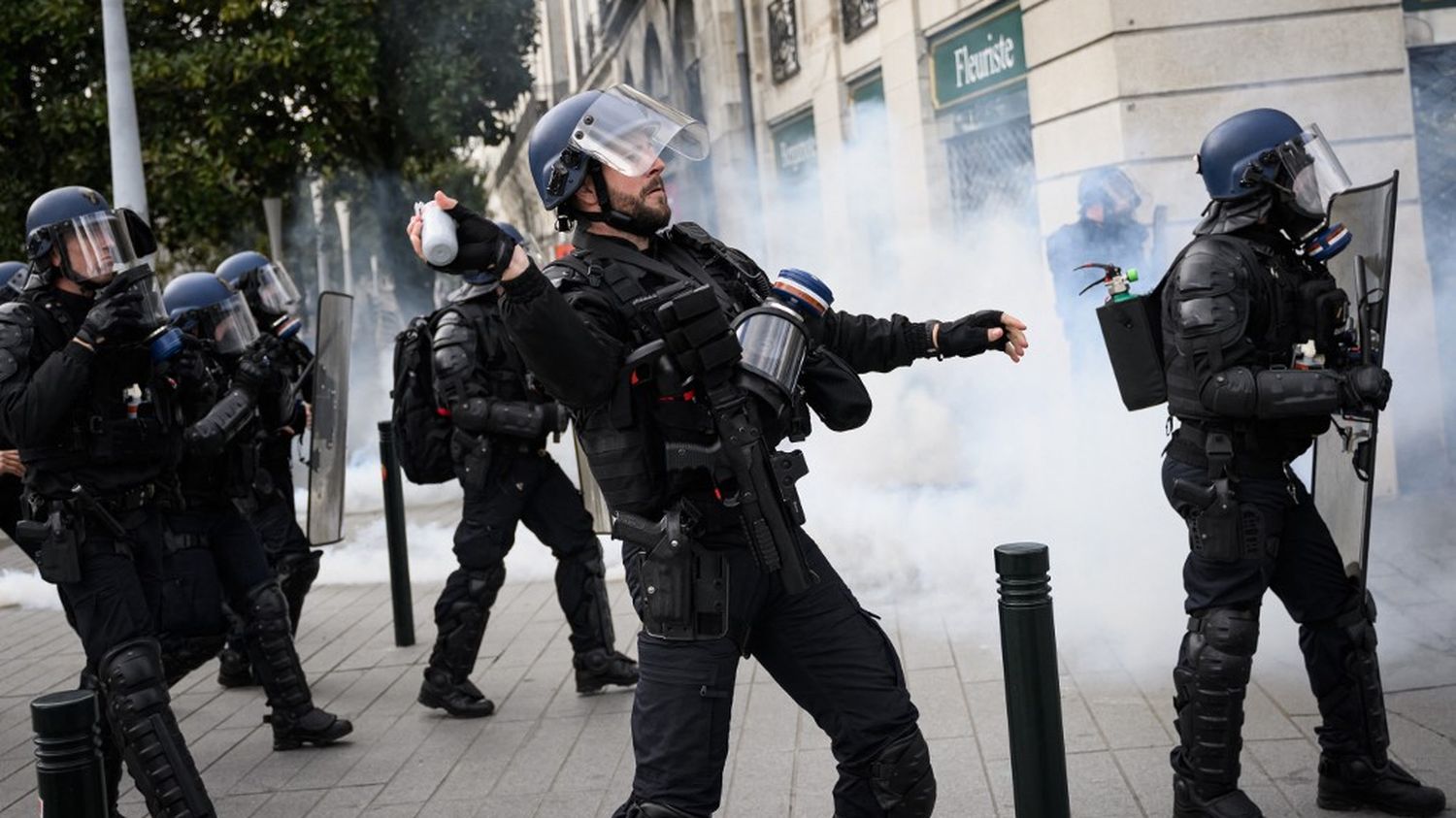Clashes between some demonstrators and police took place on the sidelines of the rallies. The police used grenades to disperse the crowd, but these objects can cause irreversible injuries.
Jets of projectiles against tear gas. Clashes opposed demonstrators to the police on Thursday, March 23, during the new day of mobilization against pension reform. In Rouen (Seine-Maritime), a demonstrator in her thirties had a torn thumb, reports France 3 Normandy, who interviewed a witness to the scene. The latter claims that the police threw tear gas and de-encirclement grenades in an attempt to disperse the demonstrators, and that the victim was injured at the time. An investigation has been opened by the Rouen public prosecutor’s office to determine the circumstances of this injury. But this mutilation raises questions about the use of these projectiles by the police.
1 What grenades can be used by law enforcement?
There are two types of grenades used in law enforcement, considered as “firearms”, “relating to war material” by the Homeland Security Code (CSI). First, tear gas grenades, which are divided into two subcategories: instantaneous and deafening, also called blast grenades. Next come the disencircling hand grenades (GMD).
Tear gas canisters. Currently, the “modular 2 tear gas grenade” (GM2L) is used, since the banning of the controversial GLI-F4 in January 2020. “The GM2L is thus one of the weapons combining tear gas and sound, but unlike the GLI-F4, it does not include explosives”, summarized at the time The world (Toarticle reserved for subscribers). Because the GLI-F4 contained 25 grams of TNT, a powerful explosive. “The Minister of the Interior at the time, Christophe Castaner, had decided to withdraw these weapons (…) which were particularly dangerous at the time of the detonation, both for hearing and for the fragments which dispersed and injured the demonstrators”reminds franceinfo Emilie Schmidt, head of safety and freedoms programs and advocacy for the NGO Acat in France.
Disencirclement hand grenades (GMD). These explosive grenades, used since 2004 in France, do not diffuse gas, but project pieces of rubber “while having a deafening effect”, emphasizes Amnesty International. They also contain an explosive charge, which produces a very loud noise and projects “18 semi-rigid rubber blocks of 9 g (…) at 126 km / h over a radius of 30 meters”, according to Acat (PDF document). But in September 2020, a new model appeared: the non-lethal burst grenade (GENL). This model, “less offensive” according to the National Law Enforcement Scheme (SNMO), causes “less overhead projections” and is “less dangerous” according to Interior Minister Gérald Darmanin. “The difference between the two grenades lies in the solidarisation of the GENL’s igniter plug with the rest of the grenade, which prevents it from being thrown during the explosion and causing involuntary injuries. The energy with which the 18 elastomer pads are projected has also been decreased”specifies the IGPN, the police force, in its last report, published in July 2022.
2 How can they be launched?
According to the SNMO, “the use of force by the internal security forces must be absolutely necessary, strictly proportionate and graduated, with appropriate means”. It is therefore to respond to the “violence that the forces must face” that these use “weapons of intermediate strength”, such as pomegranates. “Their use is framed by directives”, is it mentioned in the SNMO.
With regard to grenades, the directive in question is the “doctrine of employment common to the gendarmerie and the police of August 2, 2017”, specifies in its latest report the IGPN, which lists each year the number of munitions fired and the event during which they were used. This document is not public, but NGOs such as Amnesty International and Acat France ensure that GM2L “must be sent by rolling it on the ground, in a curve”, “by hand” and that the GMD “must always be thrown by hand at ground level and cannot be used with a thrower”.
3 What do we know about their dangerousness?
For human rights NGOs, tear gas canisters as well as de-encirclement can cause irreversible damage to demonstrators. “The GM2L resulted in numerous serious injuries, causing partial or total amputation of a limb. GMD resulted in numerous serious injuries after receiving the projectiles in the face (total or partial loss of the use of one eye)”exposed Emily Schmidt. According to her, this type of pomegranate also has cause irreversible hearing damage. It must be said that the sound of a disencirclement grenade surpasses that “of an airplane taking off and exceeds the sound pain threshold”, recalls the specialized website Maintaining order.
“Like any weapon, the grenade is likely to cause bodily harm”, recognizes the IGPN, in its latest report. Mbut she thinks that “its dangerousness is greatly reduced when the rules and recommendations for use of the GMD, provided for by the instruction of August 2, 2017, are strictly respected”.
This is the whole problem: according to Amnesty International, the use of grenades by the forces is “abusive”. “Less-lethal weapons avoid the use of firearms. But they are not harmless, and if misused, or abused, they can seriously injure or even kill.” denounces Fanny Gallois, responsible for freedoms within theNGO. The organization recalls that four years ago, the Marseillaise Zineb Redouane, 80, died after being hit in the face by a tear gas grenade fired by a CRS. “They explode by releasing mini projectiles ejected in all directions”, insists Fanny Welsh.
“France is the only European country to use explosive munitions during law enforcement operations, even though they can cause serious injuries”ensures for its part Emily Schmidt. It therefore requires “that the training of the security forces in the handling of intermediate force weapons be reinforced and updated”. She also claims the “limitation of the use of tear gas”.
